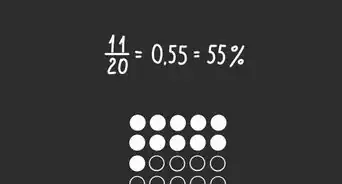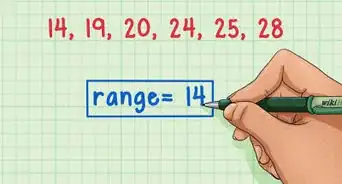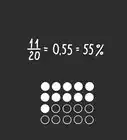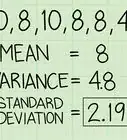This article was co-authored by wikiHow staff writer, Jennifer Mueller, JD. Jennifer Mueller is a wikiHow Content Creator. She specializes in reviewing, fact-checking, and evaluating wikiHow's content to ensure thoroughness and accuracy. Jennifer holds a JD from Indiana University Maurer School of Law in 2006.
There are 9 references cited in this article, which can be found at the bottom of the page.
This article has been viewed 22,343 times.
Learn more...
When you're writing a research paper, particularly in social sciences such as political science or sociology, statistics can help you back up your conclusions with solid data. You typically can find relevant statistics using online sources. However, it's important to accurately assess the reliability of the source. You also need to understand whether the statistics you've found strengthen or undermine your arguments or conclusions before you incorporate them into your writing.[1] [2]
Steps
Identifying the Data You Need
-
1Outline your points or arguments. Before you can figure out what kind of statistics you need, you should have a sense of what your research paper is about. A basic outline of the points you want to make or hypotheses you're trying to prove can help you narrow your focus.[3] [4]
- For example, if you're writing a research paper for a sociology class on the effect of crime in inner cities, you may want to make the point that high school graduation rates decrease as the rate of violent crime increases.
- To support that point, you would need data about high school graduation rates in specific inner cities, as well as violent crime rates in the same areas.
- From that data, you would want to find statistics that show the trends in those two rates. Then you can compare those statistics to reach a correlation that would (potentially) support your point.
-
2Do some background research. You won't truly understand what statistics are relevant to your paper until you've done a little background research. However, this doesn't mean you have to complete all your research for your paper before you start looking for statistics.[5]
- Background research also can clue you in to words or phrases that are commonly used by academics, researchers, and statisticians examining the same issues you're discussing in your research paper.
- A basic familiarity with your topic can help you identify additional statistics that you might not have thought of before.
- For example, in reading about the effect of violent crime in inner cities, you may find an article discussing how children coming from high-crime neighborhoods have higher rates of PTSD than children who grow up in peaceful suburbs.
- The issue of PTSD is something you potentially could weave into your research paper, although you'd have to do more digging into the source of the statistics themselves.
- Keep in mind when you're reading on background, this isn't necessarily limited to material that you might use as a source for your research paper. You're just trying to familiarize yourself with the subject generally.
Advertisement -
3Distinguish between descriptive and inferential statistics. Descriptive statistics, as the name suggests, merely describe a group of people or things. Inferential statistics, on the other hand, draw conclusions about a larger group based on characteristics of a representative sample.[6]
- With a descriptive statistic, those who collected the data got information for every person included in a specific, limited group.
- "Only 2 percent of the students in McKinley High School's senior class have red hair" is an example of a descriptive statistic. All the students in the senior class have been accounted for, and the statistic describes only that group.
- However, if the statisticians used the county high school's senior class as a representative sample of the county as a whole, the result would be an inferential statistic.
- The inferential version would be phrased "According to our study, approximately 2 percent of the people in McKinley County have red hair." The statisticians didn't check the hair color of every person who lived in the county.
-
4Brainstorm search terms. Typically you can find the statistics you need online. However, to find relevant data and statistics, you must identify some key words that are most likely to get you the results you need.[7]
- Finding the best key words can be an art form. Using what you learned from your background research, try to use words academics or other researchers in the field use when discussing your topic.
- You not only want to search for specific words, but also synonyms for those words. You also might search for both broader categories and narrower examples of related phenomena.
- For example, "violent crime" is a broad category that may include crimes such as assault, rape, and murder. You may not be able to find statistics that specifically track violent crime generally, but you should be able to find statistics on the murder rate in a given area.
- If you're looking for statistics related to a particular geographic area, you'll need to be flexible there as well. For example, if you can't find statistics that relate solely to a particular neighborhood, you may want to expand outward to the city or even the county.
-
5Locate relevant studies and polls. Statistics are derived from data gathered through research studies and polls. Many of these statistics, along with the raw data from which the statistics were created, can be found online.[8] [9] [10]
- While you can run a general internet search using your key words to potentially find statistics you can use in your research paper, knowing specific sources can help you find reliable statistics more quickly.
- For example, if you're looking for statistics related to various demographics in the United States, the U.S. government has many statistics available at www.usa.gov/statistics.
- You also can check the U.S. Census Bureau's website to retrieve census statistics and data.
- The NationMaster website collects data from the CIA World Factbook and other sources to create a wealth of statistics comparing different countries on a number of measures.
Evaluating Sources
-
1Judge the source's reliability. If the source of the statistics you've found isn't reliable, you can't rely on the statistics themselves either. To evaluate the reliability of the source, you'll use some of the same tools you use to evaluate the authority of a source you want to use in your research.[11] [12]
- Find out who was responsible for collecting the data, and why. If the organization or group behind the data collection and creation of the statistics has an ideological or political mission, their statistics may be suspect.
- Essentially, if someone is creating statistics to support a particular position or prove their arguments, you cannot trust those statistics. There are many ways raw data can be manipulated to show trends or correlations that don't necessarily reflect reality.
- Government sources typically are highly reliable, as are most university studies. However, even with university studies you want to see if the study was funded in whole or in part by a group or organization with an ideological or political motivation or bias.
-
2Understand the background of the data. It's much easier to interpret the statistics, as well as assess their ultimate reliability, if you get information about the background of the study or poll and the people involved in it.[13]
- To explore the background adequately, use the journalistic standard of the "5 w's" – who, what, when, where, and why.
- This means you'll want to find out who carried out the study (or, in the case of a poll, who asked the questions), what questions were asked, when was the study or poll conducted, and why the study or poll was conducted.
- The answers to these questions will help you understand the purpose of the statistical research that was conducted, and whether it would be helpful in your own research paper.
-
3Interpret the statistics yourself. Statistics are themselves an interpretation and summary of the data collected. However, once you get a statistic, you need to figure out for yourself what it means.[14] [15]
- You may find the statistics set forth in a report that describes these statistics and what they mean.
- However, just because someone else has explained the meaning of the statistics doesn't mean you should necessarily take their word for it.
- Draw on your understanding of the background of the study or poll, and look at the interpretation the author presents critically.
- Remove the statistics themselves from the text of the report, for example by copying them into a table. Then you can interpret them on your own without being distracted by the author's interpretation.
- If you create a table of your own from a statistical report, make sure you label it accurately so you can cite the source of the statistics later if you decide to include them in your research paper.
-
4Use caution when producing your own statistics. Statistical analysis is a fairly complex process. There are entire university courses dedicated to how to calculate statistics correctly – it's not simply a matter of basic math.[16] [17]
- If you're looking at raw data, you may need to actually calculate the statistics yourself. If you don't have any experience with statistics, talk to someone who does.
- Your teacher or professor may be able to help you understand how to calculate the statistics correctly.
- Even if you have access to a statistics program, there's no guarantee that the result you get actually will be accurate unless you know what information to provide the program. Remember the common phrase with computer programs: "Garbage in, garbage out."
- Don't assume you can just divide two numbers to get a percentage, for example. There are other probability elements that must be taken into account.
Writing with Statistics
-
1Use statistical terms correctly. When incorporating statistics in your paper, precise terms signal to your reader exactly how you're using the information and the conclusions you're drawing from it. Vague terms can led to confusion.[18] [19]
- For example, the word "average" is one you often see in everyday writing. However, when you're writing about statistics, the word "average" could mean up to three different things.
- The word "average" can be used to mean the median (the middle value in the set of data), the mean (the result when you add all the values in the set and then divide by the quantity of numbers in the set), or the mode (the number or value in the set that occurs most frequently).
- Therefore, if you read "average," you need to know which of these definitions is meant.
- You also want to make sure that any two or more statistics you're comparing are using the same definition of "average." Not doing so could lead to a significant misinterpretation of your statistics and what they mean in the context of your research.
-
2Focus on presentation and readability. Dumping statistics into your writing can be clunky and awkward. If you're going to introduce several related statistics, it's often better to create a table or chart that your readers can more easily grasp.[20]
- Charts and graphs also can be useful even when you are referencing the statistics within your text. Using graphical elements can break up the text and enhance reader understanding.
- Tables, charts, and graphs can be especially beneficial if you ultimately will have to give a presentation of your research paper, either to your class or to teachers or professors.
- As difficult as statistics are to follow in print, they can be even more difficult to follow when someone is merely telling them to you.
- To test the readability of the statistics in your paper, read those paragraphs out loud to yourself. If you find yourself stumbling over them or getting confused as you read, it's likely anyone else will stumble too when reading them for the first time.
-
3Choose statistics that support your arguments. It may sound obvious, but you have to be careful to insure that the statistics you're presenting actually apply to the situation you've described and bolster the point or conclusion you're trying to reach.[21]
- This often has as much to do with how you describe the statistics as the specific statistics you use.
- Keep in mind that numbers themselves are neutral – it is your interpretation of those numbers that gives them meaning.
-
4Present the data in context. Even the most appropriate statistic is meaningless unless you provide enough information that the reader can ground the information in the bigger picture. This means you may need to dig deeper to find out more about the context surrounding the data itself.[22] [23]
- For example, if you present the statistic that the murder rate in one neighborhood increased by 500 percent, and in the same period high school graduation rates decreased by 300 percent, these numbers are virtually meaningless without context.
- You don't know what a 500 percent increase entails unless you know what the rate was before the period measured by the statistic.
- When you say "500 percent," it sounds like a large amount, but if there was only one murder before the period measured by the statistic, then what you're actually saying is that during that period there were five murders.
- Additionally, your statistics may be more meaningful if you can compare them to similar statistics in other areas.
- Think of it in terms of a scientific experiment. If scientists are studying the effects of a particular drug to treat a disease, they also include a control group that doesn't take the drug. Comparing the test group to the control group helps show the drug's effectiveness.
-
5Cite the source for your statistics correctly. When using statistics in a research paper, it's important not only to provide a citation in your footnotes or bibliography, but also provide a textual citation.[24]
- For example, you might write "According to the FBI, violent crime in McKinley County increased by 37 percent between the years 2000 and 2012."
- A textual citation provides immediate authority to the statistics you're using, allowing your readers to trust the statistics and move on to the next point.
- On the other hand, if you don't state where the statistics came from, your reader may be too busy mentally questioning the source of your statistics to fully grasp the point you're trying to make.
References
- ↑ https://owl.english.purdue.edu/owl/resource/672/1/
- ↑ http://writingcenter.unc.edu/handouts/statistics/
- ↑ http://writingcenter.unc.edu/handouts/statistics/
- ↑ http://libguides.dixie.edu/c.php?g=57887&p=371711
- ↑ http://libguides.dixie.edu/c.php?g=57887&p=371711
- ↑ https://owl.english.purdue.edu/owl/resource/672/1/
- ↑ http://libguides.dixie.edu/c.php?g=57887&p=371711
- ↑ http://libguides.dixie.edu/c.php?g=57887&p=371711
- ↑ http://www.nationmaster.com/country-info/stats
- ↑ https://www.usa.gov/statistics
- ↑ https://owl.english.purdue.edu/owl/resource/672/02/
- ↑ http://writingcenter.unc.edu/handouts/statistics/
- ↑ http://writingcenter.unc.edu/handouts/statistics/
- ↑ http://writingcenter.unc.edu/handouts/statistics/
- ↑ http://libguides.lib.msu.edu/datastats
- ↑ https://owl.english.purdue.edu/owl/resource/672/02/
- ↑ https://owl.english.purdue.edu/owl/resource/672/06/
- ↑ https://owl.english.purdue.edu/owl/resource/672/02/
- ↑ http://writingcenter.unc.edu/handouts/statistics/
- ↑ https://owl.english.purdue.edu/owl/resource/672/04/
- ↑ http://writingcenter.unc.edu/handouts/statistics/
- ↑ https://owl.english.purdue.edu/owl/resource/672/02/
- ↑ http://writingcenter.unc.edu/handouts/statistics/
- ↑ https://owl.english.purdue.edu/owl/resource/672/02/









































































